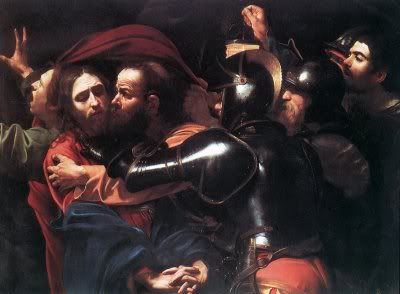The lost painting in question was “The Taking of Christ” by Caravaggio. Prior to reading the book, I have not heard of Carravagio, nor did the reproduction of the painting particularly intrigued me initially. But the book was a gift and my initiation into art history in high school has lasted me till this day, so I was quite eager to start reading it.
Perhaps because I identified with the fact that I was reading a book rather than admiring a painting, I did not notice much about the reproduction of the painting on the back cover of the book. It was only later when the book mentioned how Caravaggio was renowned for his startling use of light and shadow that I noticed his finesse at manipulating light to illuminate the expressions on his figures:
 Light, light, light. It is all about light in art isn’t it? (Cf my other entries on the Lourve and Epernay.)
Light, light, light. It is all about light in art isn’t it? (Cf my other entries on the Lourve and Epernay.)Meanwhile, I was more absorbed in how the identity of the painting was pieced together using both traditional methods (ploughing through the Mattei family archives) and modern methods (using chromatography to determine if the paint coincided with that in other Carravagios, X-rays to detect the pentimenti etc). Some 200 pages into the book, I realized that such combination of traditional and modern methods mirrored those in archaeology as well – which is to say, art historians and archaeologists actually have much in common. Funny it doesn’t seem such a revelation anymore now that I have realized it, but I have never thought of linking the two that way. In any case, I was happy to see the grand divide between art and science once again being narrowed, the way it should be. (The first time I encountered the blurring of art and science was, I believe, at a Machu Picchu exhibition at Yale. I remember being fascinated by how the staple diet of the Incas was deduced using carbon dating.) It is unfortunate that the world has a knack of dichotomizing people and subjects into art versus science. What was that debate topic I had once before? “Labels are only for jars”.
φ
Reading about Francesca’s foray into the Mattei family archives, it occurred to me that Francesca’s unborn great-granddaughter would have a much harder time should she choose to be an art historian or a biographer in this era of electronic archives and fragile hard disks. Besides, the delete button is too easy to click, too accessible by the impulse of anger… And then, too irrevocable. (Of course one can also tear up or burn letters, but the concept of destruction seems more imbued in the physical act of tearing or burning that people tend to hesitate a few more seconds before doing so than in clicking an innocuous-looking delete button.)
Even with the delete button aside, think about how incomplete an account of Virginia Woolf’s life would have been had her biographer no access to her letters, or how the mysteries surrounding Sylvia Plath and Ted Hughes would have remained mysteries forever because there would be no final archive to open in 2020. Think about how if one of us suddenly dies, one’s email account and hard disk - on which so much of modern life resides - would be accessible to no one, and then with 3 or 6 months of account inactivity in the case of the email account, be irrevocably deleted… It seems to be me therefore, that it is just as important to appoint an executor-protector for one’s electronic estate in a will. This executor-protector is quite likely to be a different person from the one who executes the division of your financial assets which requires quite a different set of qualities. This executor-protector is the one to whom you can trust Yahoo or Gmail to release your email password upon your death, the one whom you can trust with your uninhibited electronic life story, the one who has the discretion as to know which letters should be shared or published, and which should be carried with secrecy to the grave.
φ
On the day I finished reading “The Lost Painting”, I also happened to watch “The Red Violin”. It was quite fortuitous that this was the combination because one could see the parallels between the vicissitudes of a lost painting and that of a lost violin. Like the lost Carravaggio, the red violin was also Italian in birth. (To be exact, it was Cremona, the birthplace of many a great string.) The film traces the violin’s enigmatic creation and subsequent journey from an 18th century Austrian monastery, to gypsies who raided it from a tomb, to 19th century Oxford, to China during the Cultural Revolution, and then finally to an auction house in Montreal.
That night, I came a step closer to understanding why people collect antiques. It seem to me that it is so much the object itself that people collect, but rather the lives behind them. It is a way, perhaps the only way, of living vicariously the centuries that one could not have lived. No single person can outlive the violin and it is in this sense that I thought was it quite appropriate to name the violin as the leading character of the film.
I am not an antique person at all, but I think I am slowly coming to understand it. To me, it is always a delicate balance between the allure of living vicariously and becoming attached to history. Appreciating the past without attachment takes conscious effort. It is often an easier, albeit sometimes perilous, rule of thumb in life to just look ahead.
On this Sunday afternoon, maybe I will go dig up the only antique-like thing I own – an old bond certificate for the Panama Canal…
No comments:
Post a Comment